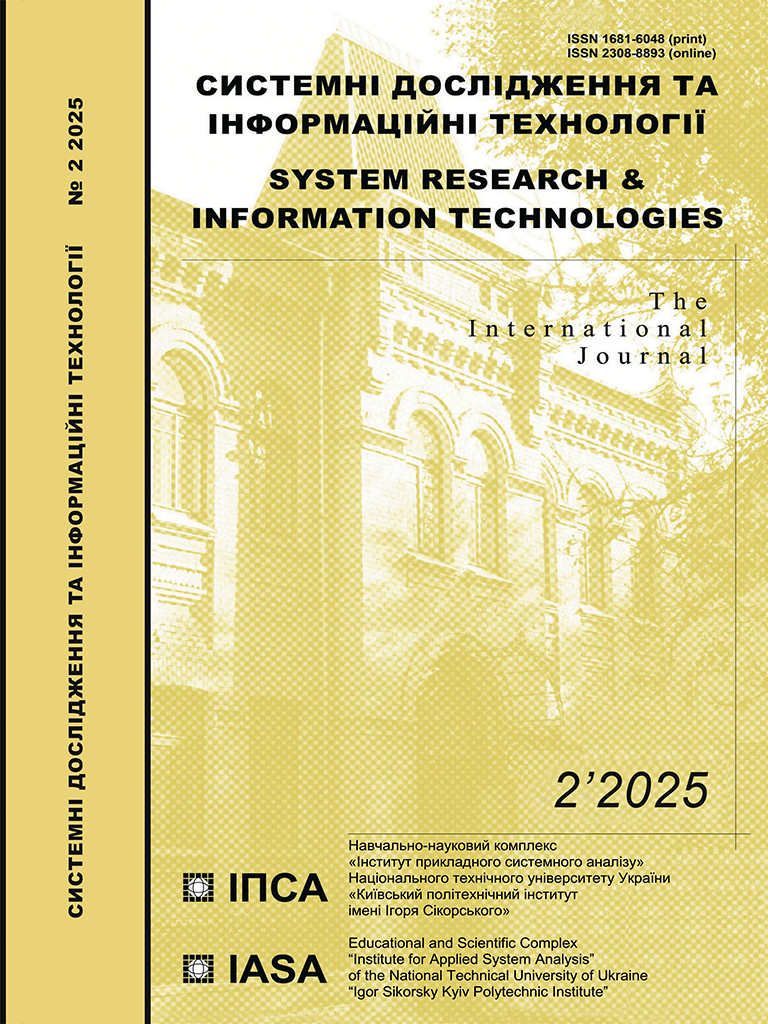Analysis of web accessibility of Ukrainian higher education institutions’ websites
DOI:
https://doi.org/10.20535/SRIT.2308-8893.2025.2.10Keywords:
web accessibility, WCAG, accessible education, inclusiveness, webpageAbstract
In today’s digital world, website content accessibility for all users, including people with disabilities, is crucial. This paper examines the accessibility of web content on the websites of Ukrainian higher education institutions to assess their compliance with modern standards and requirements. The goal is to identify problematic aspects and develop strategies for improving the accessibility of educational web resources. The study covered data from the main pages of 372 higher education institution websites, whose addresses were obtained from the Unified State Electronic Database on Education (“USEDE”). The built-in accessibility enhancement tools used on these pages were analyzed. The paper also summarizes global experience in regulating web accessibility requirements. The analyzed regulatory documents include Web Content Accessibility Guidelines version 2.1 in their rules. Automated analysis tools WAVE and Axe were used to assess website compliance with the Guidelines. Results showed that the most common problems were insufficient highlighting of hyperlinks (characteristic of 84.8% of sites, Success criteria (SC) 2.4.4, 4.1.2), insufficient element contrast (84.6%, SC 1.4.3), lack of alternative text for images (42.9%; SC 1.1.1), and non-compliance with markup and semantics requirements. The conclusions present an analysis of the problems identified during the study, along with the authors’ recommendations for addressing them. The analysis results were systematized and published on a specially created web resource. The authors plan to conduct similar studies on an ongoing basis. It is also necessary to pay attention to problems identified when using automatic analysis tools. The Axe tool identified 11.875 cases of element contrast issues, accounting for 24% of the total number of detected problems. However, this figure is not final, as it does not account for the full range of possible color perception violations and overlooks the contrast of elements against backgrounds with non-uniform colors.
References
J.D. Steinmetz et al., “Causes of blindness and vision impairment in 2020 and trends over 30 years, and prevalence of avoidable blindness in relation to VISION 2020: the Right to Sight: an analysis for the Global Burden of Disease Study,” Lancet Glob. Health, vol. 9, no. 2, pp. e144-e160, Feb. 2021. doi: 10.1016/S2214-109X(20)30489-7
“Web Accessibility,” European Commission. Shaping Europe’s digital future. Accessed on: Jan. 7, 2025. [Online]. Available: https://digital-strategy.ec.europa.eu/en/policies/web-accessibility
D. Popov, “Brief Digital Accessibility Manual,” Diia. Digital Education. Kyiv, 2023. [Online]. Available: https://www.undp.org/uk/ukraine/publications/brief-guide-on-digital-accessibility
Higher Education Institutions | Register of Educational Activity Subjects. [Online]. Available: https://registry.edbo.gov.ua/
“Convention on the Rights of Persons with Disabilities - Manual for Human Rights Education with Young people,” Council of Europe. [Online]. Available: https://www.coe.int/en/web/compass/convention-on-the-rights-of-persons-with-disabilities
K. Chupina, Youth and Disabilities EU and CoE policy framework. [Online]. Available: https://pjp-eu.coe.int/documents/42128013/47261683/Youth_and_Disabilities_CoE-EC_policy_framework_KC_final.pdf/1ae78341-b755-4b73-9c0a-eda22cc7f08f
“Section 508 of the Rehabilitation Act of 1973,” U.S. Congress. [Online]. Available: https://www.section508.gov/manage/laws-and-policies/
“Directive (EU) 2016/2102 on the accessibility of the websites and mobile applications of public sector bodies,” The European Parliament and the Council of the European Union, Oct. 26, 2016. [Online]. Available: https://eur-lex.europa.eu/legal-content/EN/TXT/PDF/?uri=CELEX:32016L2102
“Equality Act 2010,” legislation.gov.uk. [Online]. Available: https://www.legislation.gov.uk/ukpga/2010/15/contents
“Information technology — W3C Web Content Accessibility Guidelines (WCAG) 2.0.” ISO/IEC 40500:2012. [Online]. Available: https://www.iso.org/standard/58625.html
“Ukrainian developers will be able to create more online resources accessible for people with visual or hearing impairments. International WCAG 2.1 guidelines translated into Ukrainian for the first time,” Ministry of Digital Transformation of Ukraine. [Online]. Available: https://thedigital.gov.ua/news/ukrainski-rozrobniki-zmozhut-stvoryuvati-bilshe-onlayn-resursiv-dostupnikh-dlya-lyudey-z-porushennyam-zoru-chi-slukhu
“Web Content Accessibility Guidelines (WCAG) 2.1.” W3C. [Online]. Available: https://www.w3.org/TR/WCAG21/
“Accessibility Principles,” State Websites Design System. [Online]. Available: https://design.gov.ua/ua/principy-dostupnosti
“11 Best Website Accessibility Testing Tools for 2022,” UI-licious. [Online]. Available: https://uilicious.com/blog/best-website-accessibility-testing-tools/
“Web Accessibility Evaluation Tools – WAVE,” WebAIM [Online]. Available: https://wave.webaim.org/
“axe: Accessibility Testing Tools and Software,” Deque Systems. [Online]. Available: https://www.deque.com/axe/
“Web accessibility and W3C standardization services,” TAW. [Online]. Available: https://www.tawdis.net/
“Accessibility Inspector,” Mozilla Firefox Source Docs documentation. [Online]. Available: https://firefox-source-docs.mozilla.org/devtools-user/accessibility_inspector/
S. Alim, “Web accessibility of the top research-intensive universities in the UK,” SAGE Open, vol. 11, no. 4, pp. 1–9, Oct. 2021. doi: 10.1177/21582440211056614
Y. Akgül, “Accessibility, usability, quality performance, and readability evaluation of university websites of Turkey: A comparative study of state and private universities,” Universal Access Inf. Soc., Apr. 2020. doi: 10.1007/s10209-020-00715-w
O.Y. Marina, S.O. Marin, “Versions of WCAG and accessibility of library web-content,” Visnyk of Kharkiv State Academy of Culture, no. 56, Dec. 2019. doi: 10.31516/2410-5333.056.08
R.S. Savitskyi, “Accessibility of web portals of educational institutions of Ukraine,” Tech. Engineering, no. 1(91), pp. 172–177, Jul. 2023. http://doi:10.26642/ten-2023-1(91)-172-177
“One click accessibility,” Pojo.me. Accessed on: Jan. 7, 2025. [Online]. Available: https://pojo.me/plugins/accessibility
“Veks/buttonButton visually impaired,” GitHub. Accessed on: Jan. 7, 2025. [Online]. Available: https://github.com/veks/button-visually-impaired-javascript
B. Kuzikov, Web Accessibility HUB. Accessed: Jan. 7, 2025. [Online]. Available: https://web-accessibility.sumdu.edu.ua
P. Tytov, B. Kuzikov, “Formation of the training sample of the information system for assessing the compliance of sites with web accessibility requirements,” in Proc. Informatics, Mathematics, Automation (IMA-2024), Sumy, Ukraine, Apr. 26, 2024, pp. 172–173.
P. Tytov, “Aria elements,” Kaggle. [Online]. Available: https://www.kaggle.com/datasets/tytovpavel/aria-elements

